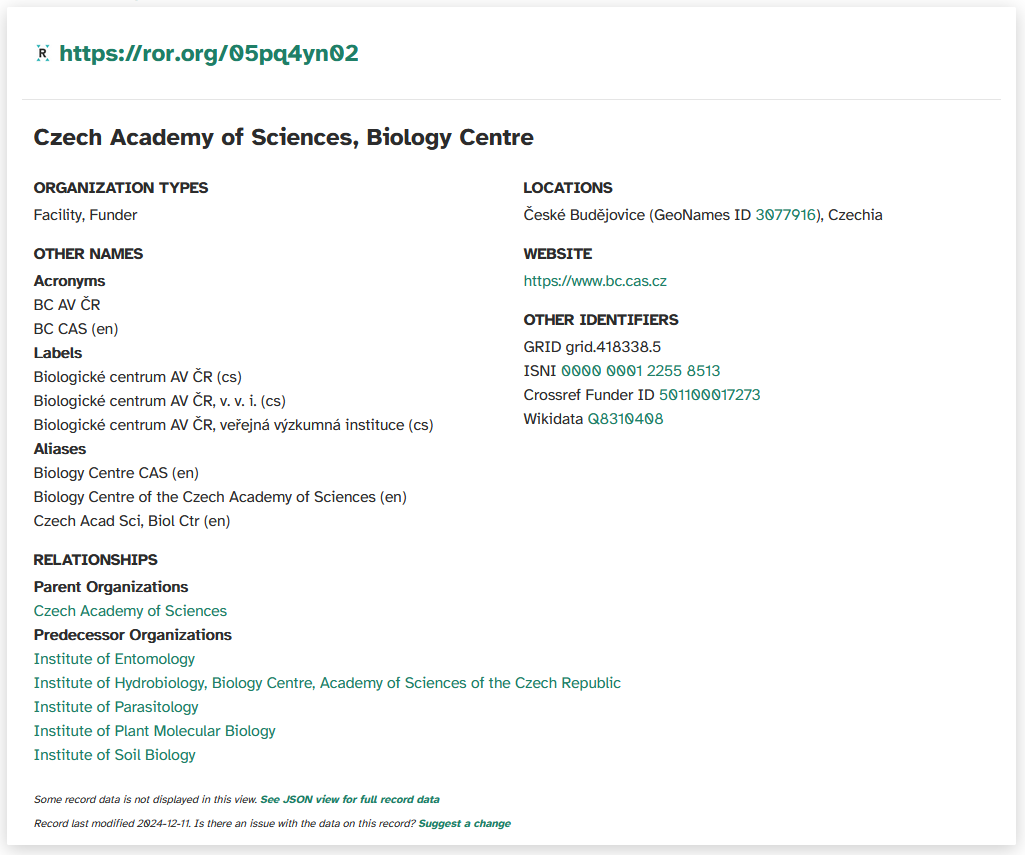ROR stands for Research Organization Registry. The Research Organization Registry (ROR) is operated as a joint initiative of the California Digital Library and the DOI identifier registration agencies Crossref and DataCite.
The ROR ID is the first and only organisation identifier specifically focused on identifying affiliations in research metadata, developed as a community initiative and designed to be integrated into the open research infrastructure. It aims to easily distinguish research organisations from each other. Organisations can change their name, merge, split, go out of business and re-emerge. Organisation names are often given in different formats and the ROR ID helps to ensure that an organisation can always be uniquely identified.
ROR records contain a unique ID for each organisation, along with other metadata about each organisation that facilitates search and identification. The ROR ID is expressed as a URL that leads to the organisation record.
Example of the Biology Centre of the Czech Academy of Sciences:

How ROR ID is used
ROR ID allows anyone or any system to easily distinguish institutional names and link research organisations to researchers and research outputs. It is used, among other things, to uniquely identify institutional affiliations, improve search and tracking of research outputs by affiliation, and facilitate Open Access publishing workflows.
The ROR identifiers are specifically designed to be implemented in any system that captures institutional affiliation and to enable linkages between research organisations, research outputs and researchers. ROR is the default identifier for organizations supported in metadata of DOI (both Crossref and DataCite) and ORCID identifiers.
ROR is used globally in journal publishing systems, data repositories, funding and grant management platforms, open access workflows and other components of the research infrastructure. Since November 2024 it has been used to identify research institutions in Clarivate’s Web of Science platform, and since January 2025 the ROR ID is also part of the data on organisations in the Czech IS VaVaI.
ROR is the first and only organization identifier that is openly available – the data is available under the CC0 license through an open REST API and a public dataset.
How to get a ROR ID
ROR can be obtained by sending basic information about the research institution to the ROR initiative, the information is evaluated by an independent, international team of editors who decide on the (non-)allocation of the identifier. Obtaining and using the ROR is free of charge.
Most research institutions based in the Czech Republic have already been allocated a ROR ID – this can be verified in the ROR register: https://ror.org/search
Who can obtain a ROR ID
ROR IDs can be obtained by any organisation that is engaged in research – i.e. produces research, funds research, employs researchers, facilitates research, manages research, publishes research, trains researchers. Common types of entities that may obtain a ROR ID include universities and colleges, commercial companies that conduct research, private foundations, government agencies, hospitals, laboratories, non-profit organizations, research institutes, or research facilities.
You can find out more about ROR in the video “The ABCs of ROR: Understanding and Using Open Identifiers for Affiliations” or on some of the ROR Community Calls.
Used sources:
Research Organization Registry (ROR) [online]. Oakland: California Digital Library, Crossref, and DataCite, 2023 [cit. 2023-08-08]. Dostupné z: https://ror.org/
COMMUNITY, ROR. ROR Data [online]. B.m.: figshare. 4. prosinec 2019 [cit. 2023-08-08]. Dostupné z: https://doi.org/10.6084/m9.figshare.c.4596503.v9
Page created:
Last updated: